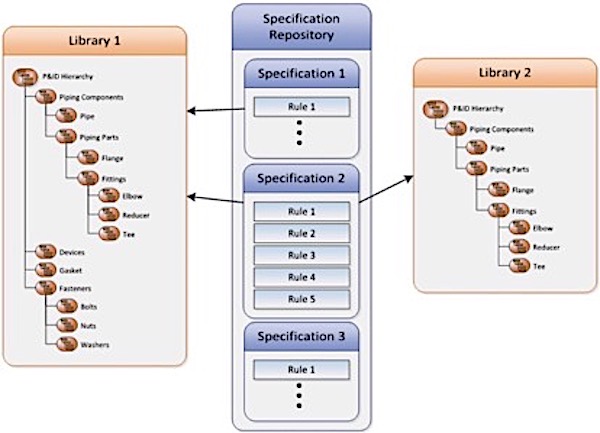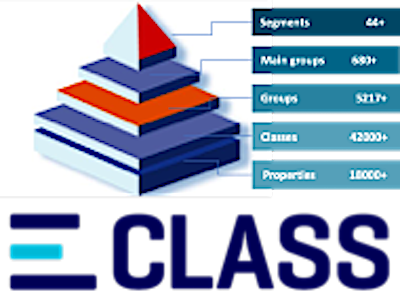Key takeaways:
- The use of Artificial Intelligence (AI) reduces the effort needed in assigning part classifications to product models.
- Teamcenter supports the fundamental ISO/IEC standards which in turn provide support for the advanced ECLASS master data standard for part classification.
- Systemic robustness ensures Teamcenter can support other standards like IEC, UNSPSC, etc., in the future.
- Newer advanced classification methods can coexist with traditional basic classification procedures in the same Teamcenter instance so users can adopt Advanced Classification at their own pace.
Classification is, by definition, a systematic arrangement of part models in groups or categories according to established criteria such as geometric shape or property values. Generally, a classification system organizes objects in a logical and systematic hierarchy, whereby like objects are grouped together based on their similarities. The implementation of an object classification and retrieval system helps reduce design and manufacturing costs by enabling previous design work and parts to be easily located and re-used.
Figure 1—A Part Classification System
(Courtesy of Siemens)
Siemens Digital Industries Software’s product lifecycle management capability within their Xcelerator portfolio supports part classification in their Teamcenter solution.[1] Teamcenter uses a Classification Presentation layer to assure interoperability between the Rich Application Client and the preferable Active Workspace clients to provide users with an intuitive, visual interface that supports added features which do not exist in the Rich Application Client.
Atop the presentation layer, Teamcenter offers a Library Management layer that leverages underlying classification information and where companies can populate purpose-based collections of parts from the Classification Presentation layer based on focused business needs. In addition, Teamcenter supports a Specification Management module where constraints can be applied from designer tools such as NX to offer only valid design data.
Once a library of parts has been created a user can apply a set of specification rules to filter the selection of valid components. For example, if the designer is selecting components for a marine industry piping design and has constraints that they must match a stainless-steel pipe, 3-inch diameter, and rated for a specific temperature and pressure, only components honoring those constraints will be shown. (See Figure 2) CIMdata views this Library and Specification Management capability as a competitive advantage for Siemens.

Figure 2—Teamcenter Specification Management
(Courtesy of Siemens)
Teamcenter AI for Classification
In a distinctive move, Siemens has introduced AI machine learning into Teamcenter’s classification module. An AI engine learns from the classification of objects in Teamcenter and builds a neural network of classification knowledge. As more components are classified, the neural network is incrementally updated to provide improved prediction accuracy. The AI engine can optionally work with Siemens’ Geolus shape search solution, for more accurate classification predictions from various data inputs augmented by a patent pending: Closed-Loop Weighted algorithm. Siemens notes that users can run auto-classifications as background jobs with built-in review mechanisms for subject matter experts to validate or change classifications. CIMdata believes this “human in-the-loop” approach will win rapid acceptance by users.
AI for classification eases the burden of classification and is an enabler to encourage companies to reuse existing components in their product designs, reducing work for the design organization. Classification AI could also provide a much-needed jump-start for organizations to align with a systematic approach of classification.
The AI classification capability is licensed separately.
Advanced Classification Supports the ECLASS Standard
Siemens brings an advanced classification capability using the ECLASS Standard. “ECLASS is a hierarchical system for grouping materials, products and services according to a logical structure with a level of detail that corresponds to the product-specific properties that can be described using norm-conforming properties.[2]” The ECLASS classification standard has established itself internationally as the only ISO/IEC-compliant industry standard.[3]
The ECLASS standard is a mature, popular classification standard that is evolving with customer participation. It conforms to the underlying standards ISO 13584-32, ISO 13584-42, IEC 61360, and DIN 4002. The ECLASS standard has shown strong acceptance in Europe and is fast growing in the Far East and North America. In the Siemens’ implementation Advanced Classification with ECLASS can co-exist with traditional classification in the same Teamcenter instances. This allows users to explore ECLASS and adopt it at their own pace.

Figure 3—ECLASS Schema
(Courtesy of Siemens)
ECLASS assists users in capturing a wholistic product description. It provides clean and unambiguous terminology for data exchange between customers and suppliers.
ECLASS establishes common data semantics for smooth and efficient data integration of enterprise systems like SCM, CRM, and ERP which will, in turn, help the Internet of Things become a reality and make possible the information-driven production processes known as Industry 4.0. The open architecture additionally allows the classification system to be adapted to an enterprise’s own internal classification scheme.
Industry 4.0 recommends ECLASS as the preferred dictionary of standardized semantic to create meaningful Asset Administration Shells (AAS) or Digital Twins. The AAS has standardized the structure and ECLASS has standardized the semantics for information elements, which should be used for the definition of digital twins.
CIMdata appreciates Siemens’ efforts to bring traditional classification capabilities into the twenty-first century with the move to AI and the emerging ECLASS Standard. Teamcenter clients will be pleased with these improvements and the ability to increase their reuse of existing part models.
[1] Research for this commentary was partially supported by Siemens Digital Industries Software.
[2] See https://wiki.eclass.eu/wiki/Main_Page.
[3] See https://www.eclass.eu/en/standard/introduction.html#c522,0,&L=2.







